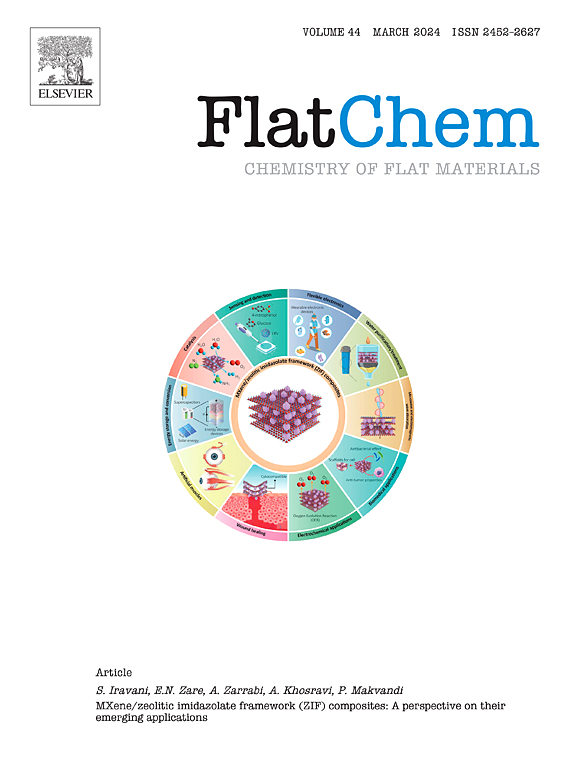研究pd包覆TiO2@g-C3N4异质结在光催化去除NO中的作用
IF 6.2
3区 材料科学
Q2 CHEMISTRY, PHYSICAL
引用次数: 0
摘要
异质结构光催化剂利用其协同特性增强光催化活性,已成为有效去除空气污染物的一种有前途的解决方案。本研究采用湿浸渍法合成Pd/TiO2@g-C3N4异质结复合材料,利用钯纳米粒子(Pd NPs)的表面等离子体共振(SPR)效应增强可见光光催化。Pd NPs平均粒径为7.2 nm,均匀分布在TiO2@g-C3N4表面,聚集最小,确保了复合材料内部的最佳相互作用。在太阳和可见光照射下,5% Pd/TiO2@g-C3N4复合材料的空气污染物氧化效率分别为77.1%和67.2%,并且在5次循环中保持较高的稳定性,产生的有毒副产物最少。这种性能的增强归因于光吸收的改善、带隙的缩小和S-scheme电荷的高效转移,Pd NPs作为电子汇促进了还原过程中活性氧的生成,同时抑制了电子-空穴的复合。在能带结构分析、俘获实验和EPR光谱的支持下,机理研究表明TiO2的光生空穴主导了氧化过程,而Pd则促进了电荷分离和氧化还原反应。这些结果强调了spr增强异质结系统作为环境修复中稳定和可持续的光催化剂的潜力。本文章由计算机程序翻译,如有差异,请以英文原文为准。

Investigating the role of Pd-coated TiO2@g-C3N4 heterojunctions in enhancing photocatalytic NO removal
Heterostructure photocatalysts have emerged as a promising solution for efficiently removing air pollutants, leveraging their synergistic properties for enhanced photocatalytic activity. In this study, Pd/TiO2@g-C3N4 heterojunction composites were synthesized via a wet impregnation method, integrating the surface plasmon resonance (SPR) effect of palladium nanoparticles (Pd NPs) to enhance visible-light photocatalysis. The Pd NPs, with an average particle size of 7.2 nm, were uniformly distributed on the TiO2@g-C3N4 surface with minimal aggregation, ensuring optimal interaction within the composite. Under solar and visible-light irradiation, the 5 % Pd/TiO2@g-C3N4 composites exhibited outstanding air pollutant oxidation efficiencies of 77.1 % and 67.2 %, respectively, while maintaining high stability over five recycling cycles with minimal formation of toxic byproducts. The enhanced performance was attributed to improved light absorption, narrowed bandgap, and efficient S-scheme charge transfer, with Pd NPs functioning as electron sinks to promote the generation of reactive oxygen species via the reduction process while suppressing electron–hole recombination. Mechanistic studies, supported by band structure analysis, trapping experiments, and EPR spectroscopy, revealed that photogenerated holes in TiO2 dominate the oxidation process, while Pd facilitates charge separation and redox reactions. These results underscore the potential of SPR-enhanced heterojunction systems as robust and sustainable photocatalysts for environmental remediation.
求助全文
通过发布文献求助,成功后即可免费获取论文全文。
去求助
来源期刊

FlatChem
Multiple-
CiteScore
8.40
自引率
6.50%
发文量
104
审稿时长
26 days
期刊介绍:
FlatChem - Chemistry of Flat Materials, a new voice in the community, publishes original and significant, cutting-edge research related to the chemistry of graphene and related 2D & layered materials. The overall aim of the journal is to combine the chemistry and applications of these materials, where the submission of communications, full papers, and concepts should contain chemistry in a materials context, which can be both experimental and/or theoretical. In addition to original research articles, FlatChem also offers reviews, minireviews, highlights and perspectives on the future of this research area with the scientific leaders in fields related to Flat Materials. Topics of interest include, but are not limited to, the following: -Design, synthesis, applications and investigation of graphene, graphene related materials and other 2D & layered materials (for example Silicene, Germanene, Phosphorene, MXenes, Boron nitride, Transition metal dichalcogenides) -Characterization of these materials using all forms of spectroscopy and microscopy techniques -Chemical modification or functionalization and dispersion of these materials, as well as interactions with other materials -Exploring the surface chemistry of these materials for applications in: Sensors or detectors in electrochemical/Lab on a Chip devices, Composite materials, Membranes, Environment technology, Catalysis for energy storage and conversion (for example fuel cells, supercapacitors, batteries, hydrogen storage), Biomedical technology (drug delivery, biosensing, bioimaging)
 求助内容:
求助内容: 应助结果提醒方式:
应助结果提醒方式:


